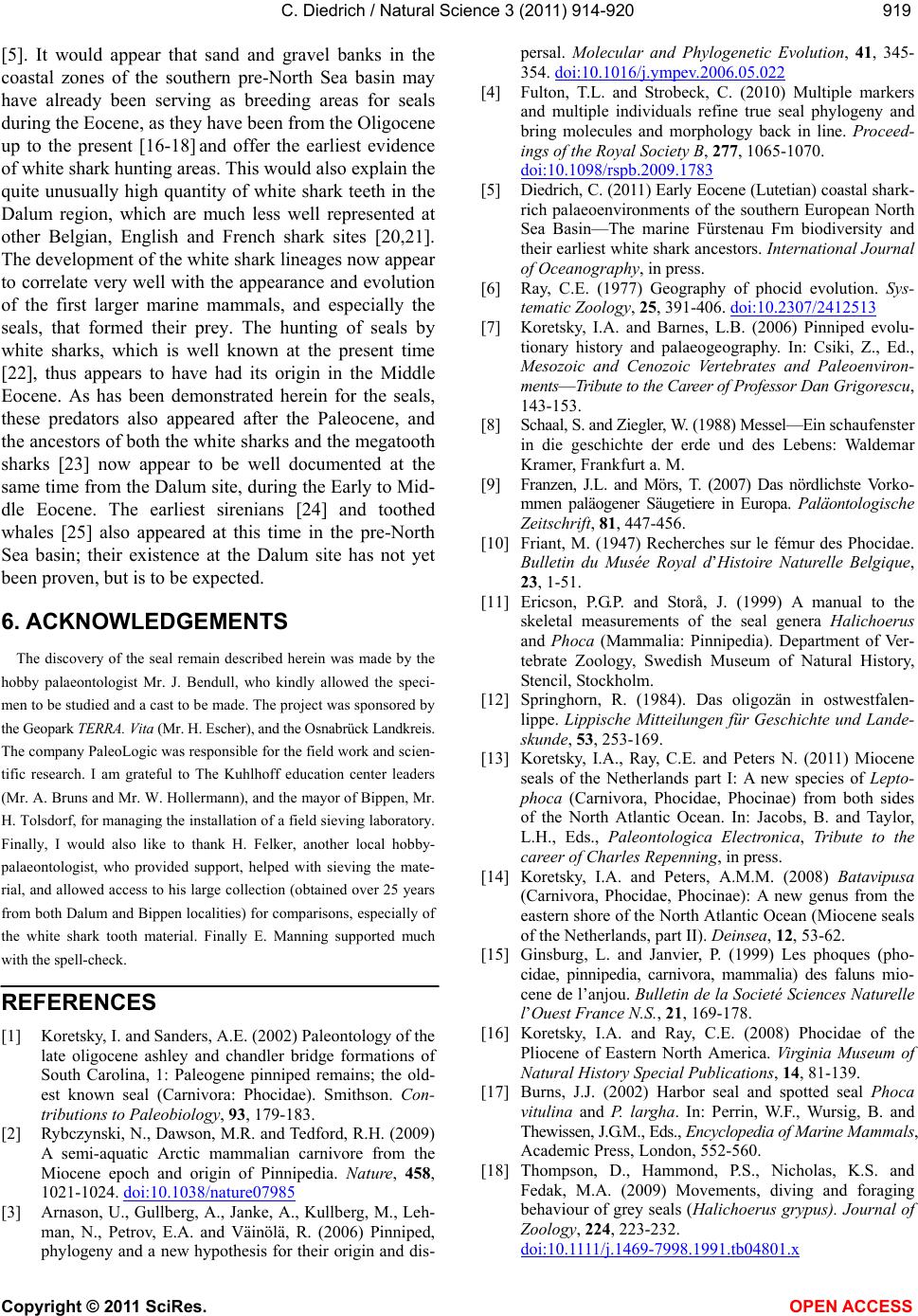
C. Diedrich / Natural Science 3 (2011) 914-920
Copyright © 2011 SciRes. OPEN ACCESS
919919
[5]. It would appear that sand and gravel banks in the
coastal zones of the southern pre-North Sea basin may
have already been serving as breeding areas for seals
during the Eocene, as they have been from the Oligocene
up to the present [16-18] and offer the earliest evidence
of white shark hunting areas. This would also explain the
quite unusually high quantity of white shark teeth in the
Dalum region, which are much less well represented at
other Belgian, English and French shark sites [20,21].
The development of the white shark lineages now appear
to correlate very well with the appearance and evolution
of the first larger marine mammals, and especially the
seals, that formed their prey. The hunting of seals by
white sharks, which is well known at the present time
[22], thus appears to have had its origin in the Middle
Eocene. As has been demonstrated herein for the seals,
these predators also appeared after the Paleocene, and
the ancestors of both the white sharks and the megatooth
sharks [23] now appear to be well documented at the
same time from the Dalum site, during the Early to Mid-
dle Eocene. The earliest sirenians [24] and toothed
whales [25] also appeared at this time in the pre-North
Sea basin; their existence at the Dalum site has not yet
been proven, but is to be expected.
6. ACKNOWLEDGEMENTS
The discovery of the seal remain described herein was made by the
hobby palaeontologist Mr. J. Bendull, who kindly allowed the speci-
men to be studied and a cast to be made. The project was sponsored by
the Geopark TERRA. Vita (Mr. H. Escher), and the Osnabrück Landkreis.
The company PaleoLogic was responsible for the field work and scien-
tific research. I am grateful to The Kuhlhoff education center leaders
(Mr. A. Bruns and Mr. W. Hollermann), and the mayor of Bippen, Mr.
H. Tolsdorf, for managing the installation of a field sieving laboratory.
Finally, I would also like to thank H. Felker, another local hobby-
palaeontologist, who provided support, helped with sieving the mate-
rial, and allowed access to his large collection (obtained over 25 years
from both Dalum and Bippen localities) for comparisons, especially of
the white shark tooth material. Finally E. Manning supported much
with the spell-check.
REFERENCES
[1] Koretsky, I. and Sanders, A.E. (2002) Paleontology of the
late oligocene ashley and chandler bridge formations of
South Carolina, 1: Paleogene pinniped remains; the old-
est known seal (Carnivora: Phocidae). Smithson. Con-
tributions to Paleobiology, 93, 179-183.
[2] Rybczynski, N., Dawson, M.R. and Tedford, R.H. (2009)
A semi-aquatic Arctic mammalian carnivore from the
Miocene epoch and origin of Pinnipedia. Nature, 458,
1021-1024. doi:10.1038/nature07985
[3] Arnason, U., Gullberg, A., Janke, A., Kullberg, M., Leh-
man, N., Petrov, E.A. and Väinölä, R. (2006) Pinniped,
phylogeny and a new hypothesis for their origin and dis-
persal. Molecular and Phylogenetic Evolution, 41, 345-
354. doi:10.1016/j.ympev.2006.05.022
[4] Fulton, T.L. and Strobeck, C. (2010) Multiple markers
and multiple individuals refine true seal phylogeny and
bring molecules and morphology back in line. Proceed-
ings of the Royal Society B, 277, 1065-1070.
doi:10.1098/rspb.2009.1783
[5] Diedrich, C. (2011) Early Eocene (Lutetian) coastal shark-
rich palaeoenvironments of the southern European North
Sea Basin—The marine Fürstenau Fm biodiversity and
their earliest white shark ancestors. International Journal
of Oceanography, in press.
[6] Ray, C.E. (1977) Geography of phocid evolution. Sys-
tematic Zoology, 25, 391-406. doi:10.2307/2412513
[7] Koretsky, I.A. and Barnes, L.B. (2006) Pinniped evolu-
tionary history and palaeogeography. In: Csiki, Z., Ed.,
Mesozoic and Cenozoic Vertebrates and Paleoenviron-
ments—Tribute to the Career of Professor Dan Grigorescu,
143-153.
[8] Schaal, S. and Ziegler, W. (1988) Messel—Ein schaufenster
in die geschichte der erde und des Lebens: Waldemar
Kramer, Frankfurt a. M.
[9] Franzen, J.L. and Mörs, T. (2007) Das nördlichste Vorko-
mmen paläogener Säugetiere in Europa. Paläontologische
Zeitschrift, 81, 447-456.
[10] Friant, M. (1947) Recherches sur le fémur des Phocidae.
Bulletin du Musée Royal d’Histoire Naturelle Belgique,
23, 1-51.
[11] Ericson, P.G.P. and Storå, J. (1999) A manual to the
skeletal measurements of the seal genera Halichoerus
and Phoca (Mammalia: Pinnipedia). Department of Ver-
tebrate Zoology, Swedish Museum of Natural History,
Stencil, Stockholm.
[12] Springhorn, R. (1984). Das oligozän in ostwestfalen-
lippe. Lippische Mitteilungen für Geschichte und Lande-
skunde, 53, 253-169.
[13] Koretsky, I.A., Ray, C.E. and Peters N. (2011) Miocene
seals of the Netherlands part I: A new species of Lepto-
phoca (Carnivora, Phocidae, Phocinae) from both sides
of the North Atlantic Ocean. In: Jacobs, B. and Taylor,
L.H., Eds., Paleontologica Electronica, Tribute to the
career of Charles Repenning, in press.
[14] Koretsky, I.A. and Peters, A.M.M. (2008) Batavipusa
(Carnivora, Phocidae, Phocinae): A new genus from the
eastern shore of the North Atlantic Ocean (Miocene seals
of the Netherlands, part II). Deinsea, 12, 53-62.
[15] Ginsburg, L. and Janvier, P. (1999) Les phoques (pho-
cidae, pinnipedia, carnivora, mammalia) des faluns mio-
cene de l’anjou. Bulletin de la Societé Sciences Naturelle
l’Ouest France N.S., 21, 169-178.
[16] Koretsky, I.A. and Ray, C.E. (2008) Phocidae of the
Pliocene of Eastern North America. Virginia Museum of
Natural History Special Publications, 14, 81-139.
[17] Burns, J.J. (2002) Harbor seal and spotted seal Phoca
vitulina and P. largha. In: Perrin, W.F., Wursig, B. and
Thewissen, J.G.M., Eds., Encyclopedia of Marine Mammals,
Academic Press, London, 552-560.
[18] Thompson, D., Hammond, P.S., Nicholas, K.S. and
Fedak, M.A. (2009) Movements, diving and foraging
behaviour of grey seals (Halichoerus grypus). Journal of
Zoology, 224, 223-232.
doi:10.1111/j.1469-7998.1991.tb04801.x